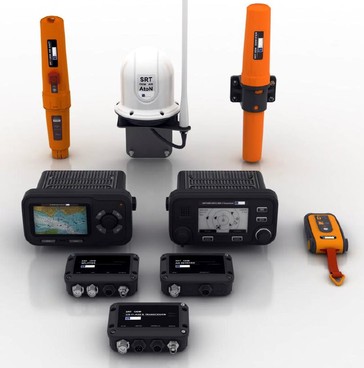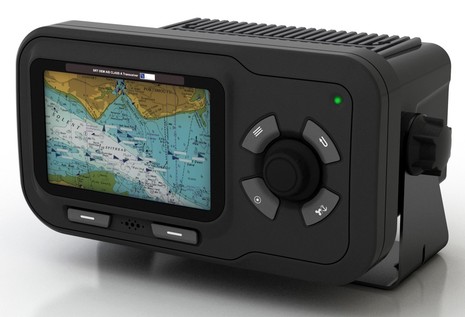SRT’s 2011 OEM AIS products, a boat load
The AIS Summit began today in Hamburg, Germany, and SRT took the occasion to announce a boat load of newly available OEM AIS modules (download PDF here). Of course that means that other companies have to brand and sell the gear above — or build their own devices based the same internal technology — but I have reason to believe that in at least one interesting case that will happen soon, and, in fact, several of the items above seem like they will be interesting products eventually…
At the top of my list is the new Class B unit, which is based on the miniaturized Cobalt module we first heard about last May, and saw a photograph of in July. It not only claims higher performance in a smaller, more power-efficient package but it also has NMEA 2000 support built in. Given that we’ve seen some problems with the early N2K AIS devices, I was glad to get assurance from SRT that Cobalt outputs every standard PGN possible.
You’ll see in the press release that SRT is also touting a new feature called “Rmax” which purportedly translates AIS messages into NMEA 0183 and 2000 so fast that the dual receivers in Cobalt and the various other new generation modules can maintain maximum range even in very AIS busy areas. I was also told that these modules contain “significant spare processing capacity on board to allow the implementation of new features and applications by our customers without adding huge cost and complexity”…
I will have some detail on what sure looks like a Cobalt-based Class B tomorrow, but in the meantime, enjoy a gander at SRT’s MOB System below (click on images for bigger versions). It might also be called a Personal AIS SART, like the easyRescue I started testing last month. So far I’m pretty impressed with the idea of using AIS for crew overboard situations, and it may be that SRT has improved the possibilities.
Also seen in the press release is something called an “Identifier” which looks a lot like a full-sized AIS SART in family photo at top…except that it will go a week without a recharging and apparently it’s tamper proof in several ways. I’m vauge on what the applications for this are — maybe a quick, secure way to ID boats in a place like the Panama Canal, or during a group cruise? — but it’s nearly sure to upset those who fear that AIS will be misused to somehow limit their freedoms.
Finally, SRT has also added an encryption option (for navies and such) to the compact Class A transponder design launched last year, which can be had as the ComNav Voyager X3 or the Comar CSA 300 or maybe in other forms. It won’t be available until 2012 but SRT is also showing off this prototype of a new Class A with a color screen and “full charting ability.” Judging from the button icons, it looks like it may also have the ability to stand anchor watch, or at least a shortcut for changing a vessel’s nav status from underway to moored. Hopefully both!

















Ben, you need to wait atleast until I get the new toys in-hand before you tell me about even newer toys. Ordered the Garmin Class B Transceiver last week because it was the only N2K option… now you tell me there are more… doh!
Patrick — Garmin is not the only N2k option Simrad (Navico) has the NAIS 300… A Class B type that transmits and receives and has NMEA 2000/SimNet/NMEA 0183. We have installed this unit on few boats and it works fine, this unit has been out now for quite some time.
Jeffrey Schwartz / Miami
Jeffrey, Patrick may have meant that the Garmin has the only N2K AIS receiver that outputs all the standard N2K AIS messages. To my knowledge neither Navico’s nor Raymarine’s devices put out the correct Class B Static Data message. Each has a work around for their own plotters, but you will not see a Class B vessel’s name, type, and dimensions on someone else’s plotter if it’s getting the info via N2K from those receivers or transponders. Navico and Raymarine were not trying to be proprietary when this all happened; NMEA had not yet issued the Class B static data PGN. But they should fix it now.
You are right Ben – I suppose that Simrad will address this with a software update in the near future.
I was not aware of the SIMRAD AIS solution, for some reason SIMRAD never really shows up in my research or holds mindshare with me. No idea why that is, it just is.
I do have a probably unfounded fear of SIMNET. I see SIMNET and I think non-standard NMEA, or at least re-branded NMEA either of which I’m not a fan of. But like I said, I’m not sure if that’s a valid opinion or not.
Patrick – we recently have completed two total s/v retro fits, one with Garmin electronics and Raymarine autopilot, and the other with “All” Simrad. The Simrad equipment (IMHO) is far better to use and interface, there was no comparing the two…. not that the Garmin 5212 and GMi10’s are bad, just not as “good” at the Simrad. The Simnet cables are very easy to route in the boat and the interface to standard N2k fittings was simple and not overly expensive.
No doubt that the “big brother” view is advancing along with AIS technology, witness some of the Agenda items at the AIS Summit
“11:00 “Collaboration in Space for International Global Maritime Awareness (C-SIGMA)“, Guy Thomas, Science & Technology Advisor, United States Coast Guard”
“11:00 “Using Satellite-AIS as a new data stream for an Integrated Maritime Surveillance Platform” ,Fabritius Gaetan, CLS, Ramonville St Agne – France”
11:40 “DLR AIS Satellite” – DLR, Susanne Lehner
12:00 “LuxSpace global satellite AIS data service – our experience after 3 years of operation“, Luxspace, Luxemburg, Gerd Eiden
13:40 “Global AIS Coverage by ORBCOMM Satellites“, George Best, ORBCOMM USA
14:00 “Exact Earth Satellite System“, John Allan, Vice President, Global Sales & Marketing Exact Earth Cambridge, Ontario, Canada
14:20 “cost-effective maritime surveillance applications using nanosatellites“, ISIS, Delft, Jeroen Rotteveel
Interesting topics
Dave